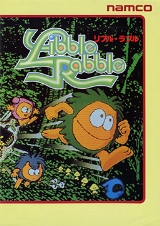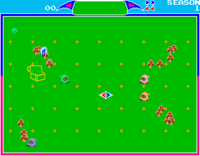
Libble Rabble
Encyclopedia
is an arcade game
developed and published by Namco
in December 1983. It was the first 16-bit
arcade game Namco ever created. It is a curious but challenging game where the player tries to harvest little mushrooms (Mushlins) while avoiding various enemies.
 At first glance, the gameplay resembles Taito
At first glance, the gameplay resembles Taito
's Qix
. You control two "arrows", one red (Libble) and one blue (Rabble), with a line strung between them. The object is to wrap the line around poles and surround mushrooms or enemies with the line. You can either close the loops yourself (worth more points for the mushrooms) or move both arrows to the same edge of the screen. You clear a "season" when you harvest all the mushrooms.
Along the way, various enemies will appear to try to stop you. The most common are four hooded little critters (Hobblins) that start each season in the corners. If you catch them in a loop, you can pen them in the top of the screen for a while. Other critters such as fireballs, sparks, and demons may also appear. These can be destroyed by closing a loop around them. Sometimes, scissors-like enemies appear, and if they cross your line, they cut it. If your line is ever cut by scissors or demons, a new one is instantly made: directly between the two arrows.
Every so often when you close a line, a detector goes off indicating that the area you closed off has a treasure chest somewhere. To actually uncover the chest, you must surround a small enough area to cover just the chest and no other possible hiding places. The game guides you along that step, first by challenging you to uncover a chest in the beginning of the game and then by revealing the locations of the chests in the first two stages. When you actually uncover a chest, six bonus creatures will also pop out and make for the edges. Corral them with your line and then close the loop to score the bonus for them: they mean bonus letters. If you manage to finish a bonus word, the stage is automatically cleared out and you move to a bonus stage where you try to uncover and collect chests (to collect a chest, you need to close a loop around an opened chest) within a time limit.
You lose a life if any of the assorted critters touch one of the arrows or if you run out of time (the border is your timer, and you can boost your time by looping mushrooms and plants), and you gain extra lives at 40,000, 120,000, 200,000, 400,000, 600,000 and 1,000,000 points. At the 100th season, the level counter will stay at 99.
, the FM Towns Marty
and the Super Famicom
.
In Battle City
, also by Namco, one of the maps resemble the Hobblins. The game's theme was used in one of the levels of the Pac-Man Vs.
port to the Nintendo DS
as part of Namco Museum DS. The game's theme was also used as Shion Uzuki's cell phone ringtone in Xenosaga
, a game also by Namco for the Sony
PlayStation 2
.
Arcade game
An arcade game is a coin-operated entertainment machine, usually installed in public businesses such as restaurants, bars, and amusement arcades. Most arcade games are video games, pinball machines, electro-mechanical games, redemption games, and merchandisers...
developed and published by Namco
Namco
is a Japanese corporation best known as a former video game developer and publisher. Following a merger with Bandai in September 2005, the two companies' game production assets were spun off into Namco Bandai Games on March 31, 2006. Namco Ltd. was re-established to continue domestic operation of...
in December 1983. It was the first 16-bit
16-bit
-16-bit architecture:The HP BPC, introduced in 1975, was the world's first 16-bit microprocessor. Prominent 16-bit processors include the PDP-11, Intel 8086, Intel 80286 and the WDC 65C816. The Intel 8088 was program-compatible with the Intel 8086, and was 16-bit in that its registers were 16...
arcade game Namco ever created. It is a curious but challenging game where the player tries to harvest little mushrooms (Mushlins) while avoiding various enemies.
Gameplay

Taito Corporation
The is a Japanese publisher of video game software and arcade hardware wholly owned by publisher Square Enix. Taito has their headquarters in the Shinjuku Bunka Quint Building in Yoyogi, Shibuya, Tokyo, sharing the facility with its parent company....
's Qix
Qix
Qix is an arcade game, released by Taito America Corporation in 1981.-Gameplay:The objective of Qix is to fence off, or “claim”, a supermajority of the playfield...
. You control two "arrows", one red (Libble) and one blue (Rabble), with a line strung between them. The object is to wrap the line around poles and surround mushrooms or enemies with the line. You can either close the loops yourself (worth more points for the mushrooms) or move both arrows to the same edge of the screen. You clear a "season" when you harvest all the mushrooms.
Along the way, various enemies will appear to try to stop you. The most common are four hooded little critters (Hobblins) that start each season in the corners. If you catch them in a loop, you can pen them in the top of the screen for a while. Other critters such as fireballs, sparks, and demons may also appear. These can be destroyed by closing a loop around them. Sometimes, scissors-like enemies appear, and if they cross your line, they cut it. If your line is ever cut by scissors or demons, a new one is instantly made: directly between the two arrows.
Every so often when you close a line, a detector goes off indicating that the area you closed off has a treasure chest somewhere. To actually uncover the chest, you must surround a small enough area to cover just the chest and no other possible hiding places. The game guides you along that step, first by challenging you to uncover a chest in the beginning of the game and then by revealing the locations of the chests in the first two stages. When you actually uncover a chest, six bonus creatures will also pop out and make for the edges. Corral them with your line and then close the loop to score the bonus for them: they mean bonus letters. If you manage to finish a bonus word, the stage is automatically cleared out and you move to a bonus stage where you try to uncover and collect chests (to collect a chest, you need to close a loop around an opened chest) within a time limit.
You lose a life if any of the assorted critters touch one of the arrows or if you run out of time (the border is your timer, and you can boost your time by looping mushrooms and plants), and you gain extra lives at 40,000, 120,000, 200,000, 400,000, 600,000 and 1,000,000 points. At the 100th season, the level counter will stay at 99.
Ports and related releases
Libble Rabble was later ported to the Sharp X68000Sharp X68000
The Sharp X68000, often referred to as the X68k, is a home computer released only in Japan by the Sharp Corporation. The first model was released in 1987, with a 10 MHz Motorola 68000 CPU, 1 MB of RAM and no hard drive; the last model was released in 1993 with a 25 MHz Motorola 68030...
, the FM Towns Marty
FM Towns Marty
The FM Towns Marty was a fifth-generation video game console released in 1993 by Fujitsu, exclusively for the Japanese market. It was the first 32-bit home video game system, and came complete with a built in CD-ROM drive and disk drive. It was based on the earlier FM Towns computer system Fujitsu...
and the Super Famicom
Super Nintendo Entertainment System
The Super Nintendo Entertainment System is a 16-bit video game console that was released by Nintendo in North America, Europe, Australasia , and South America between 1990 and 1993. In Japan and Southeast Asia, the system is called the , or SFC for short...
.
In Battle City
Battle City (video game)
Battle City is a multi-directional shooter video game for the Nintendo Family Computer produced and published in 1985 by Namco. The game was later released for the Game Boy and was included in the Japanese version of Star Fox: Assault...
, also by Namco, one of the maps resemble the Hobblins. The game's theme was used in one of the levels of the Pac-Man Vs.
Pac-Man Vs.
is a Pac-Man video game originally designed exclusively for the Nintendo GameCube that was included as an extra bonus disc with the Player's Choice edition of Pac-Man World 2...
port to the Nintendo DS
Nintendo DS
The is a portable game console produced by Nintendo, first released on November 21, 2004. A distinctive feature of the system is the presence of two separate LCD screens, the lower of which is a touchscreen, encompassed within a clamshell design, similar to the Game Boy Advance SP...
as part of Namco Museum DS. The game's theme was also used as Shion Uzuki's cell phone ringtone in Xenosaga
Xenosaga
is a series of science fiction video games developed by Monolith Soft and published by Namco Bandai. Xenosaga's main story is in the form of a trilogy of PlayStation 2 video games. There have been three spin-off games and an anime adaptation. The Xenosaga series serves as a spiritual successor to...
, a game also by Namco for the Sony
Sony
, commonly referred to as Sony, is a Japanese multinational conglomerate corporation headquartered in Minato, Tokyo, Japan and the world's fifth largest media conglomerate measured by revenues....
PlayStation 2
PlayStation 2
The PlayStation 2 is a sixth-generation video game console manufactured by Sony as part of the PlayStation series. Its development was announced in March 1999 and it was first released on March 4, 2000, in Japan...
.
External links
- Libble Rabble at arcade-history

